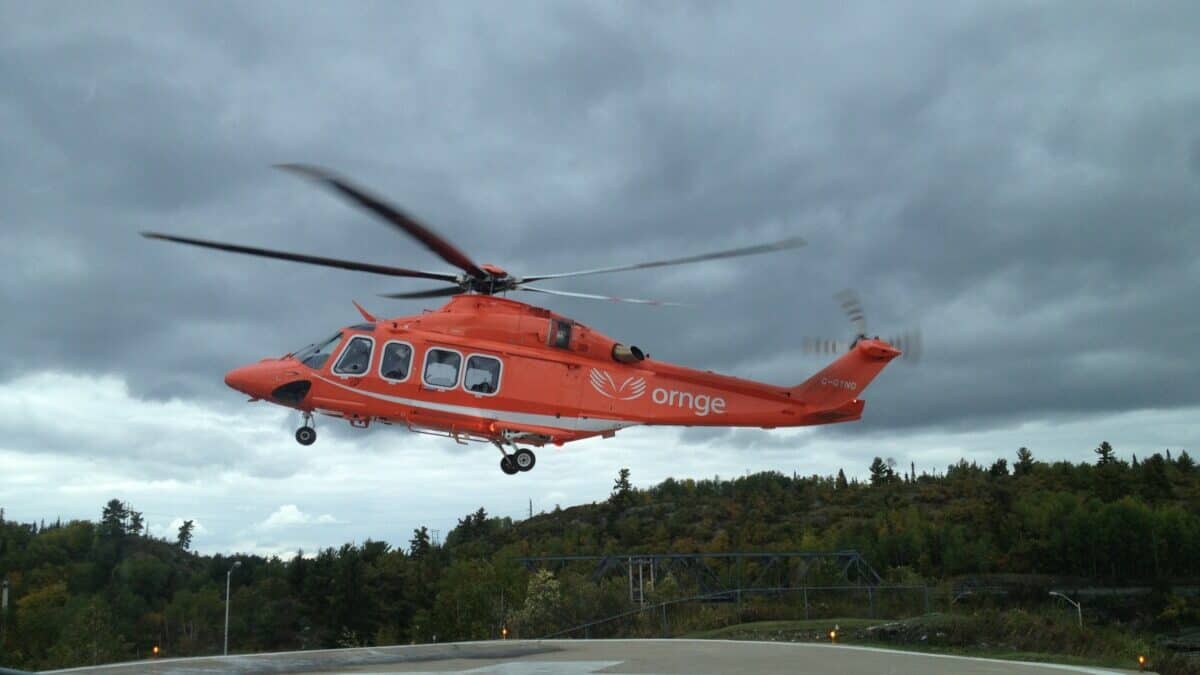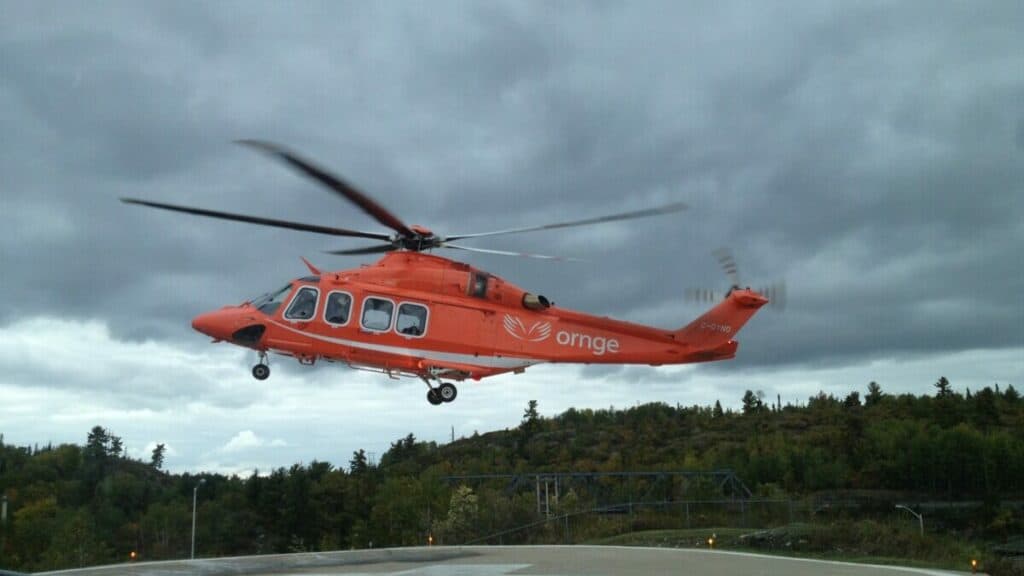
Helicopters are a marvel of engineering and aerodynamics. Their unique design allows them to operate in the most demanding of environments, whether winching a stranded hiker off a cliff face, placing towers for a ski lift up the side of a mountain, or landing in the grounds of a high-end restaurant. Helicopters are a very unique machine and as a helicopter pilot, I’m always asked how they work.
Helicopters work by rotating 2 or more airfoils around a main shaft to create lift. An engine drives the main transmission which turns the main rotor and the tail rotor systems. Pilots control the helicopter using a Collective control, Cyclic control, & Anti-Torque pedals.
Many people say helicopters are just 1000 parts trying to separate from each other in a spectacular fashion while others talk about how precise and highly engineered they are. I have both opinions and to this day they truly amaze me as to how well they work.
If you wish to find out how they really work, I’ll give you the full tour from the pilot’s perspective…
How Do Helicopters Create Lift?
Helicopters create lift by rotating airfoils through the air. As air flows over each airfoil it deflects air downward as each blade pitches upwards. The more the pitch, the more air it deflects downward, the more lift it creates. When lift is greater than the weight of the helicopter it lifts off.
The way in which a helicopter is unique is that it has a rotating set of wings mounted on top of the fuselage, unlike an airplane where its wings are fixed and it relies on engine thrust to move it through the air to generate lift from its wings. By rotating its wings a helicopter does not need to move through the air for it to generate lift. This is why it can hover.
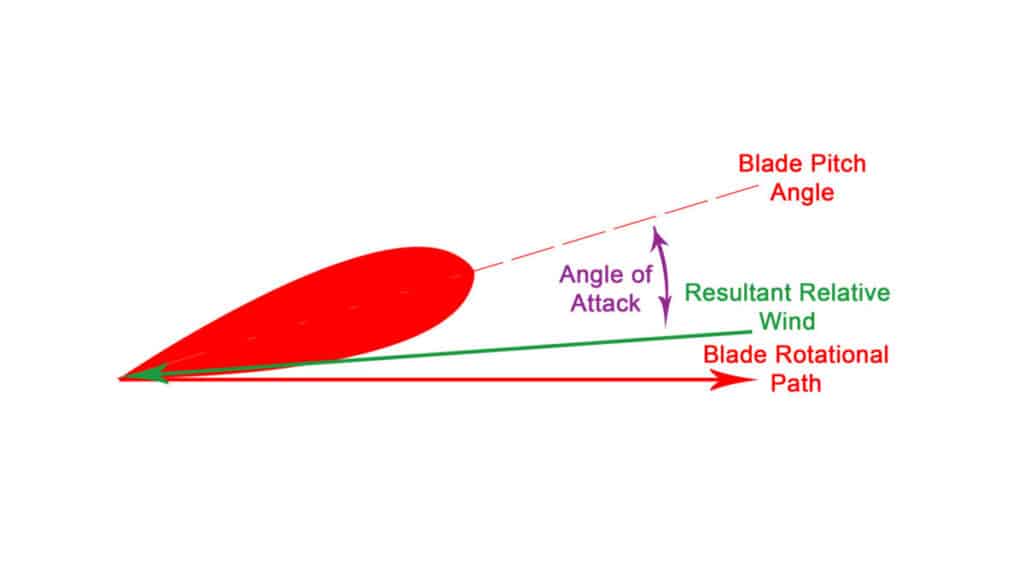
To control how lift is created each main rotor blade (wing) can change its angle – known as its Pitch Angle. The more pitch angle the rotor blade reaches, the more air it deflects downward. For a helicopter to climb the rotor system creates uniform lift across all its main rotor blades and pushes the helicopter aloft.
To turn, the helicopter rotor blades create more lift on one side of the helicopter compared to the other causing the helicopter to bank in that direction.
Let’s take a look at each main system and how it allows a helicopter to work:
What are the Main Systems that Allow a Helicopter to Work?
The main systems on a helicopter are:
- Main Rotor System
- Engine & Transmission
- Tail Rotor System
- Flight Controls
Main Rotor System:
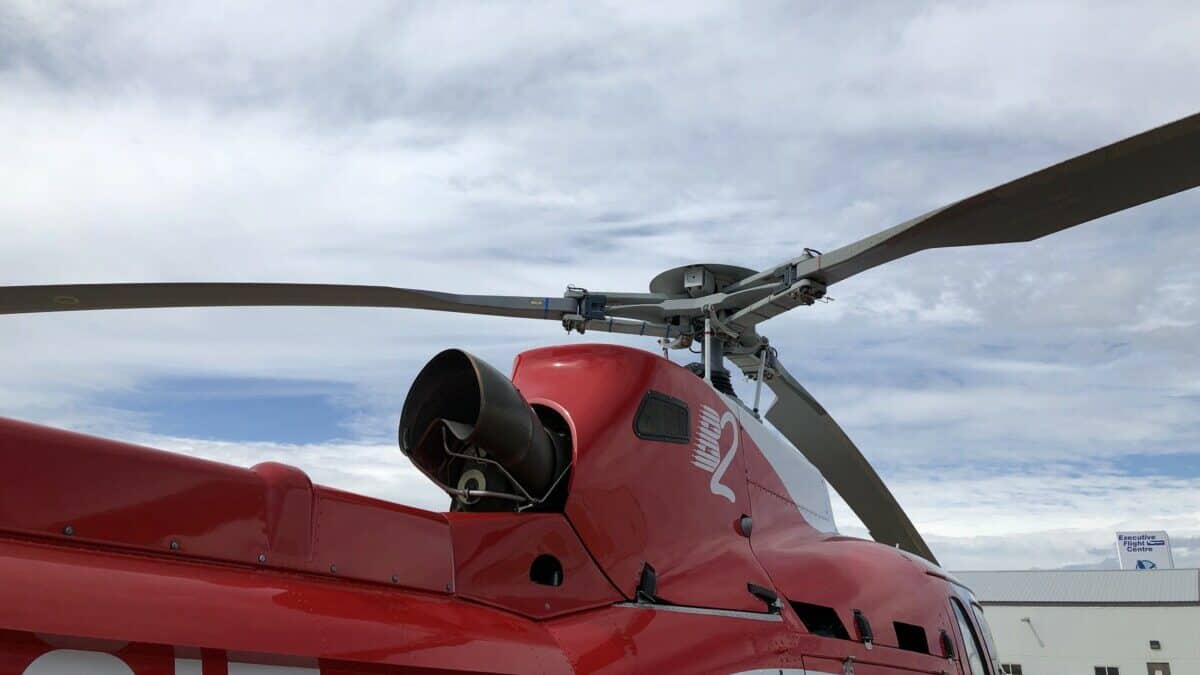
The main rotor system on a helicopter comprises the main rotor blades, the hub, the swashplate, and the control rods.
The hub is attached to the top of the mast. The mast is essentially a drive shaft coming vertically out of the main transmission. Each main rotor blade is attached to the hub. Depending on the type of main rotor system design there can be 1-3 hinges between the hub and each rotor blade.

The hinges allow each main rotor blade to twist and move independently of the hub. The main job of the hub is to rotate each rotor blade through the air.
Helicopters can contain anywhere from 2-8 main rotor blades depending on the size and design of the helicopter.
If you would like to know more about why helicopters have different numbers of main rotorblades please see this article:
This is Why Helicopters Have Different Numbers of Rotor Blades?
To control how each main rotor blade moves or operates the helicopter uses a ‘Swashplate’. The swashplate is comprised of three parts:
- Stationary Half
- Rotating Half
- Spherical Bearing
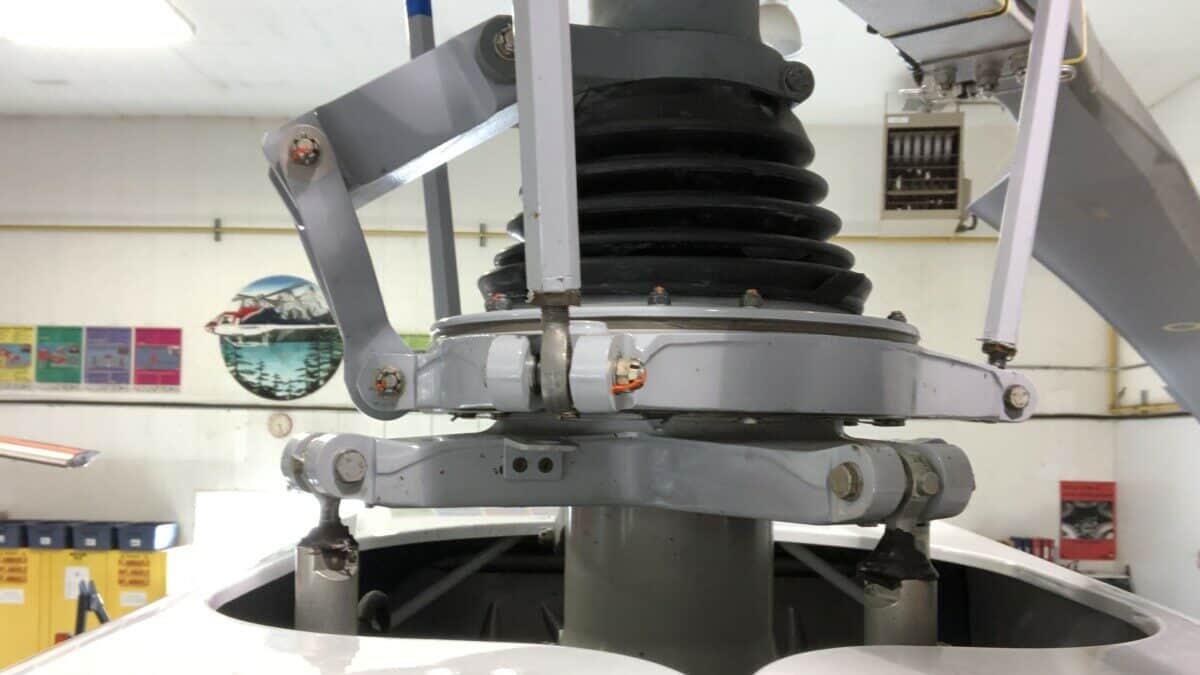
As the pilot manipulates the flight controls they move control rods that connect to the lower stationary half of the swashplate.
These control movements tilt the swashplate assembly around its spherical bearing. Each half sits on the bearing with the mast passing through the middle.
The rotating half is connected to the stationary half via another bearing and mirrors the tilt placed into the stationary half.

The stationary half only tilts, while the rotating half tilts and rotates around as the mast turns. Pitch Control Linkages join each main rotor blade to the rotating half of the swashplate. This is how the helicopter transfers control inputs from the pilot’s controls into the rotating main rotor blades to adjust their pitch angle.
Engine & Transmission:
Helicopters are fitted with either a piston-powered or gas-turbine-powered engine. Small helicopters used for training and private ownership up to around 4-5 seats will use a piston engine, but once more seats are required, helicopters will have one, two, or even three gas-turbine turboshaft engines fitted. Gas turbine engines produce far more power for their size compared to a piston engine of similar size.
A turboshaft gas turbine engine is just like a jet engine fitted to an airplane but instead of using the escaping gas to push the airplane through the air, it drives a ‘Power Turbine’ inside the engine. This turbine is connected to an output shaft that is then used to drive the main transmission.
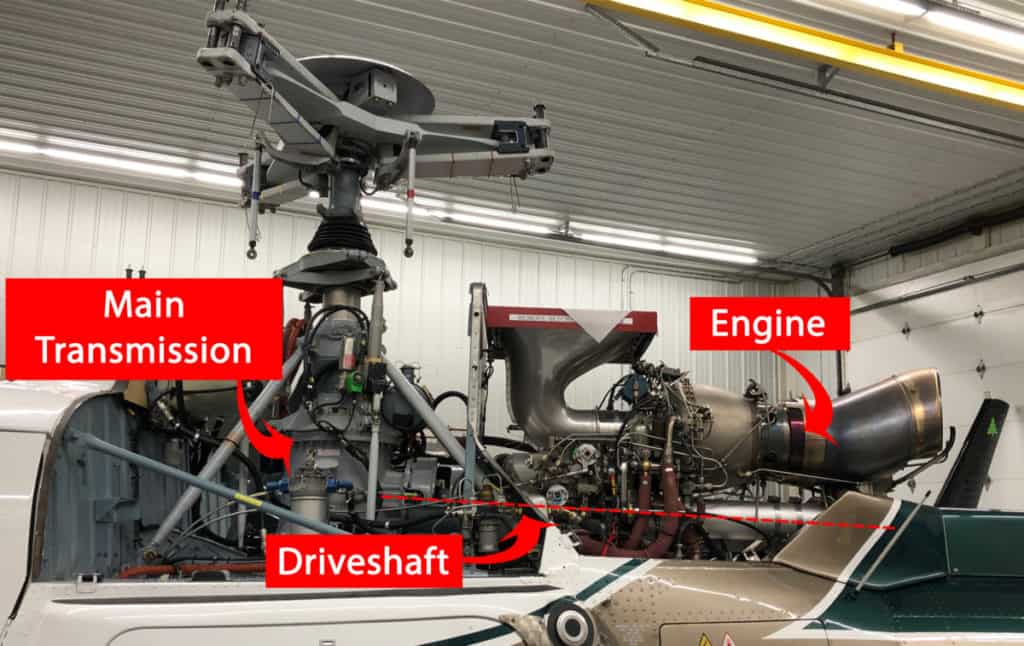
The main transmission drives both the main rotor system and tail rotor systems together. One cannot turn without the other turning. The engine’s job is to turn the rotor systems at a constant RPM to allow the airfoils (Main and Tail Rotor Blades) to create lift and thrust as they rotate through the air.
As more weight is lifted or the main rotor system creates more drag, more engine power is required. The engine/s will increase/reduce power via either an electronic fuel control system or a mechanical linkage that operates the throttle just like on your car. The engine’s power demand comes from the pilot’s flight controls.
Tail Rotor System:
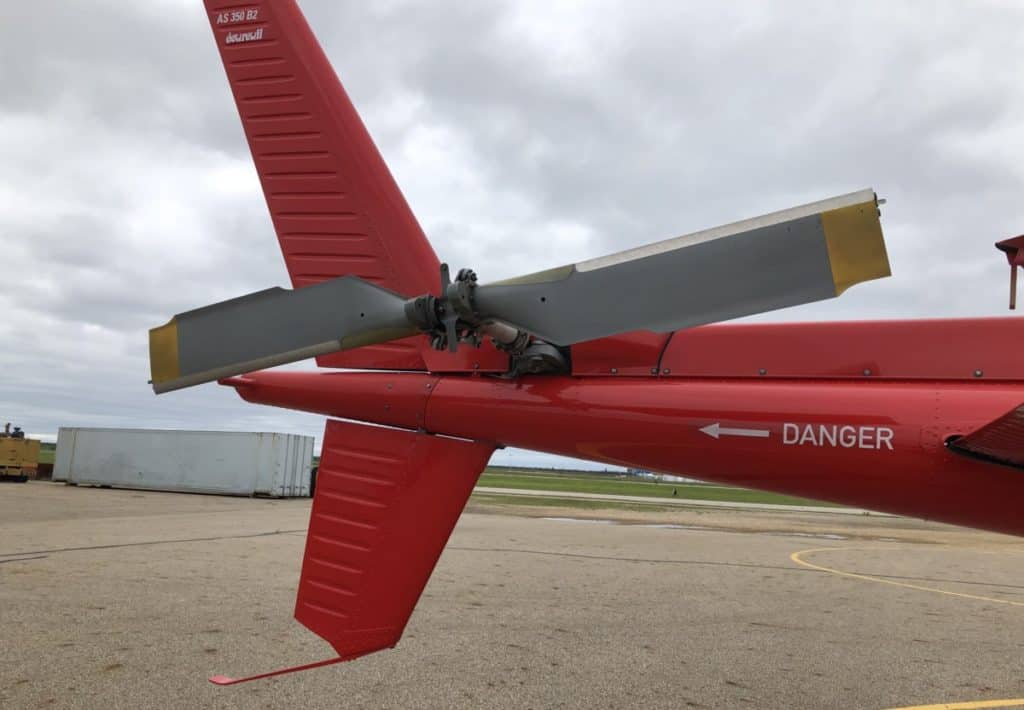
When the main rotor system turns it imparts torque into the fuselage. Because of Newton’s Third Law of Motion ‘For every action, there is an equal and opposite reaction’, as soon as the helicopter lifts off the ground the torque will want to spin the fuselage in the opposite rotation to the main rotor system if nothing is there to prevent it.
If you have ever been drilling a hole and the drill bit bites and the drill then wants to rip out of your hand, that is torque.
To prevent the helicopter from spinning due to torque, the helicopter is fitted with a tail rotor or ‘Anti-Torque’ system. This is a small set of airfoils that instead of creating an upward lift force, they create a horizontal thrust.
That thrust is directed in the opposite direction to which the fuselage wants to rotate. When the thrust balances torque the helicopter will remain facing in one direction.
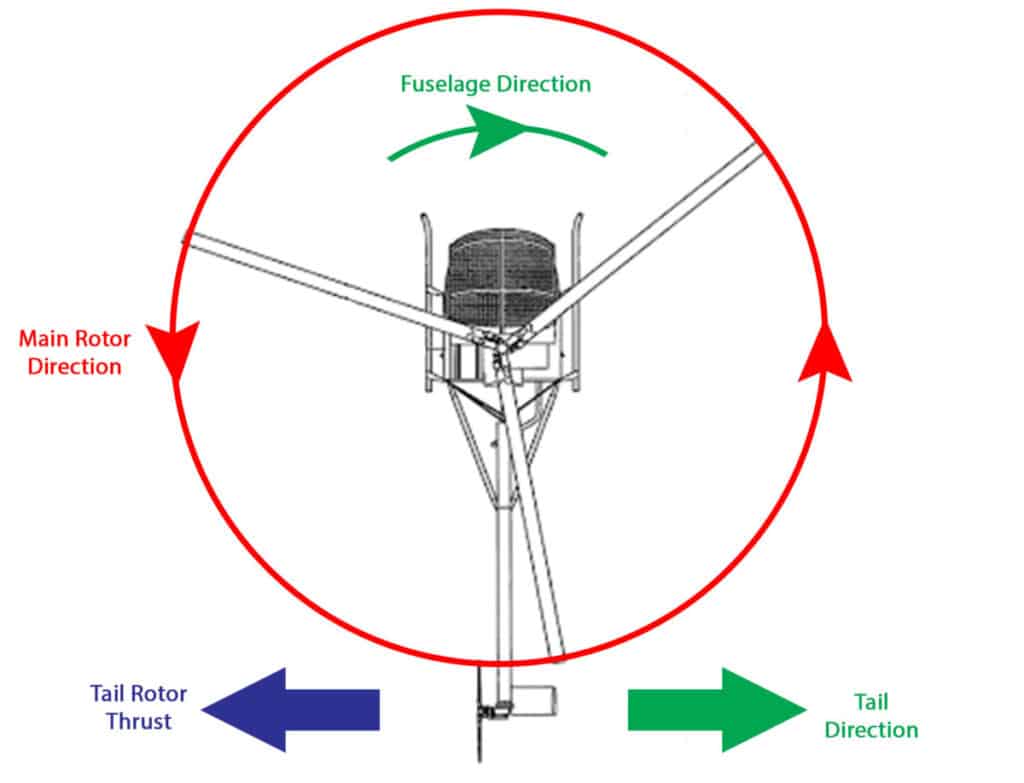
The pilot then fine-tunes this thrust by adjusting the pitch angle of the tail rotor blades to maintain rotational control of the nose of the helicopter.
If you wish to learn more about the different types of tail rotor or Anti-Torque systems a helicopter can be fitted with please check out this article:
Helicopter Tail Rotors – The Different Types Explained
Flight Controls:
To maneuver the helicopter the pilot uses three flight controls:
Collective
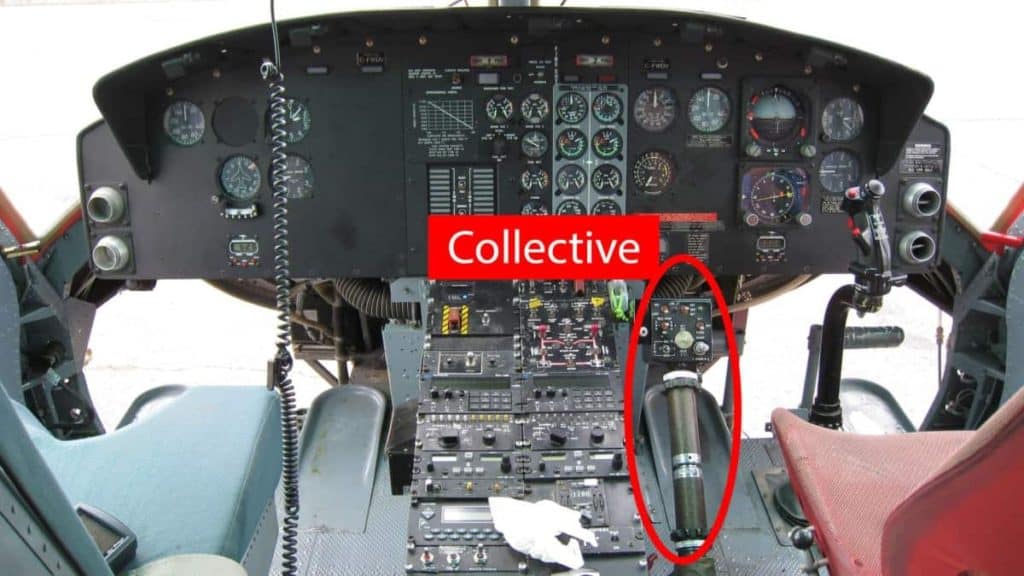
This is in the left hand of the pilot. When they raise the collective the connecting linkages cause the swashplate to rise up the mast and increase the pitch angle of ALL the main rotorblades ‘Collectively’ thus creating uniform lift on each main rotor blade causing the helicopter to climb. The more the collective is raised the greater the pitch angle is increased on each main rotor blade, and the more lift they create.
As the pilot lowers the collective it lowers the swashplate and reduces the pitch angle on ALL of the main rotor blades which reduces the amount of lift they create. Once lift created is less than the weight of the helicopter, the helicopter will begin to descend.
When you were a kid, did you ever place your hand out of the window of a moving car? With your palm flat and parallel to the ground your hand didn’t move, but as you began to tilt or ‘pitch’ your palm upward your hand would want to rise and be forced backward. The rising is the lift created by your palm deflecting air downward and the backward force is the aerodynamic drag your palm creates on the airflow.
This is what is happening to each main rotor blade as it rotates around the helicopter and the pilot raises the collective.
If the engine did not increase power this drag would slow the RPM of the main rotor system causing the helicopter to not produce lift and no longer fly.
To prevent this reduction in rpm from drag, the collective on modern helicopters also controls two devices called a ‘Correlator’ and a ‘Governor’. The correlator is a mechanical linkage that mechanically controls the engine throttle and a governor is an electronic device that tries to fine-tune the throttle to maintain the main rotor RPM at a set rpm.
These devices automatically command the throttle on the engine/s to increase power to overcome the drag the main rotor blades create as they increase in pitch angle as the collective is raised.
On older helicopters, the throttle used to be manually controlled by the pilot. The throttle was mounted on the end of the collective lever like the handgrip on a motorcycle. As the pilot raised the collective they would have to rotate their hand and open the throttle.
They would need to balance the raising and twisting to maintain the main rotor rpm in the green band. As they lowered the collective they would then need to gradually close the throttle to prevent the main rotor rpm from overspeeding.
The correlator or governor now makes this function a non-event for the pilot, unless the governor fails at which point the pilot will have to manually adjust the throttle.
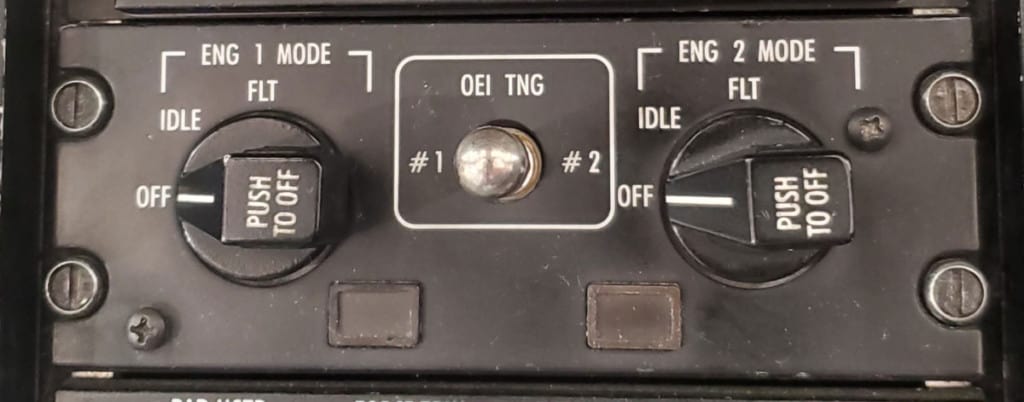
Once the engine/s are started the throttle is placed into the ‘Flight’ position by the pilot and remains there for the duration of the flight. The correlator and governor then adjust the engine to maintain the main rotor rpm (usually around 400rpm in most helicopters).
To hover a helicopter the pilot will raise the collective to get it airborne, then at around 5 feet above the ground, they will slightly lower the collective to a point where the lift being produced exactly matches the weight of the helicopter. At this point, the helicopter will neither climb nor descend and will therefore hover.
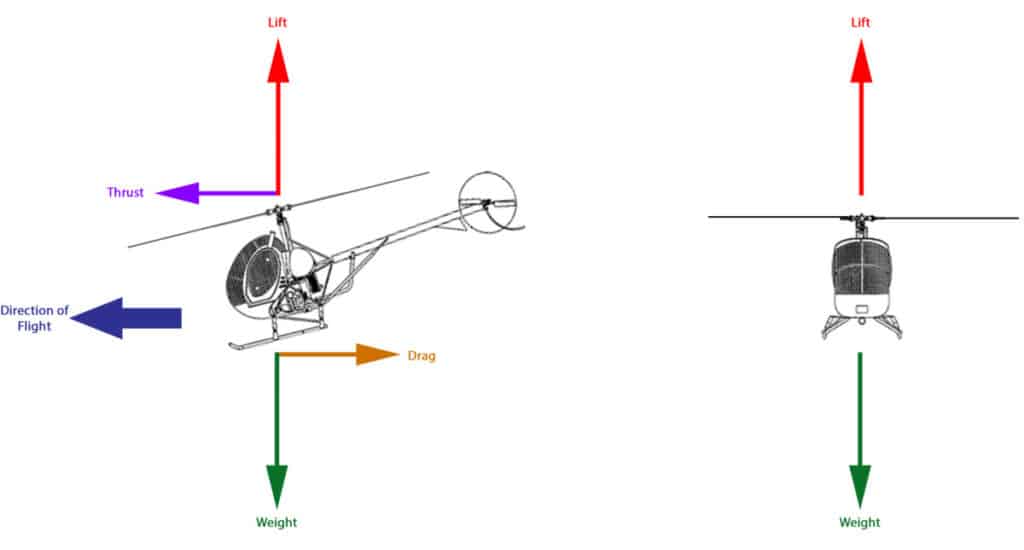
To prevent the helicopter from moving from that spot the pilot uses another control – The Cyclic.
Cyclic
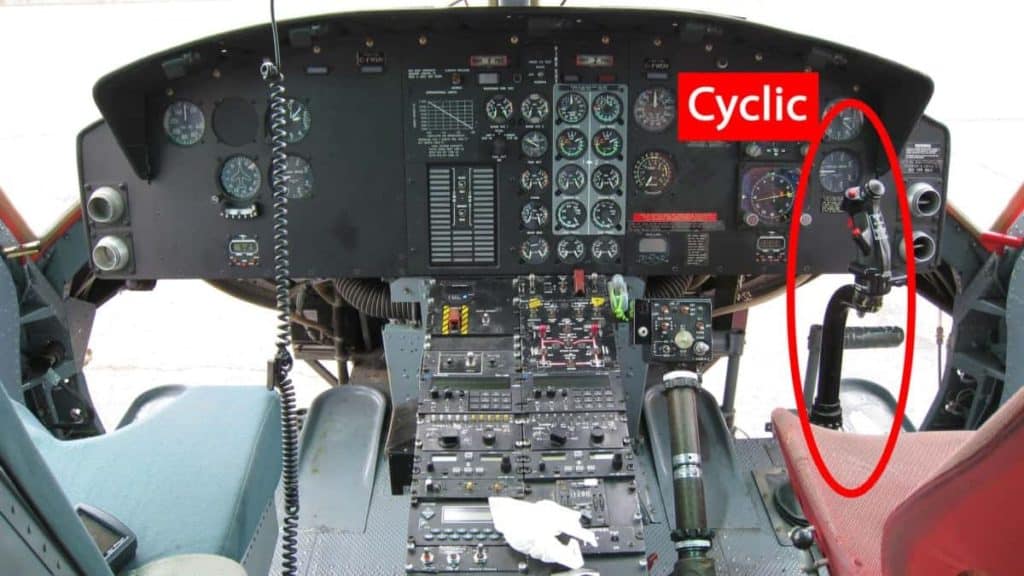
This is in the right hand of the pilot. This is the directional control of the helicopter. When the pilot pushes the cyclic or ‘Cyclic Pitch Control Lever’ in any direction, control rods transfer that input to the swashplate. When the main rotor system is turning it looks like a disk. To keep this explanation simple, the swashplate tilts the main rotor disk in the direction the pilot wishes to go.
There are far more complex things going on here but I’m trying to keep it simple for this article. If you would like a far more in-depth explanation of how a helicopters flight control system works please see this article:
How Do Helicopter Controls Work? Pilot Tells All!
Basically, if the pilot wishes to accelerate into forward flight from the hover they will apply a slight forward pressure on the cyclic. The linkages connecting to the swashplate will tilt the stationary half of the swashplate higher at the rear, and lower at the front. The rotating half of the swashplate mirrors this tilt and causes the rotor disk to drop at the front and rise at the rear.
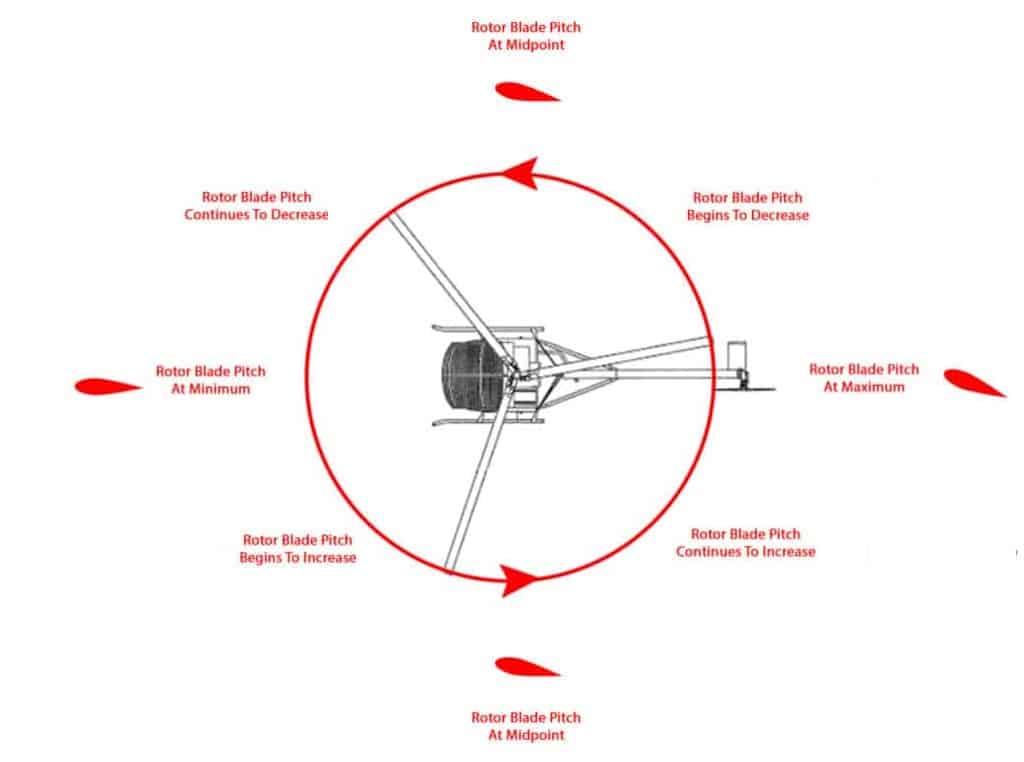
This disk tilt is done by creating a high pitch on each main rotor blade as it rotates around to the rear of the helicopter. This allows it to generate more lift causing it to rise. As the blade continues to rotate towards the front of the helicopter its pitch angle reduces creating less lift and causing it to fall. As each blade does this it looks like the disk tilts up at the rear and drops in the front.
The same action happens in any direction the pilot moves the cyclic.
Anti-Torque Pedals
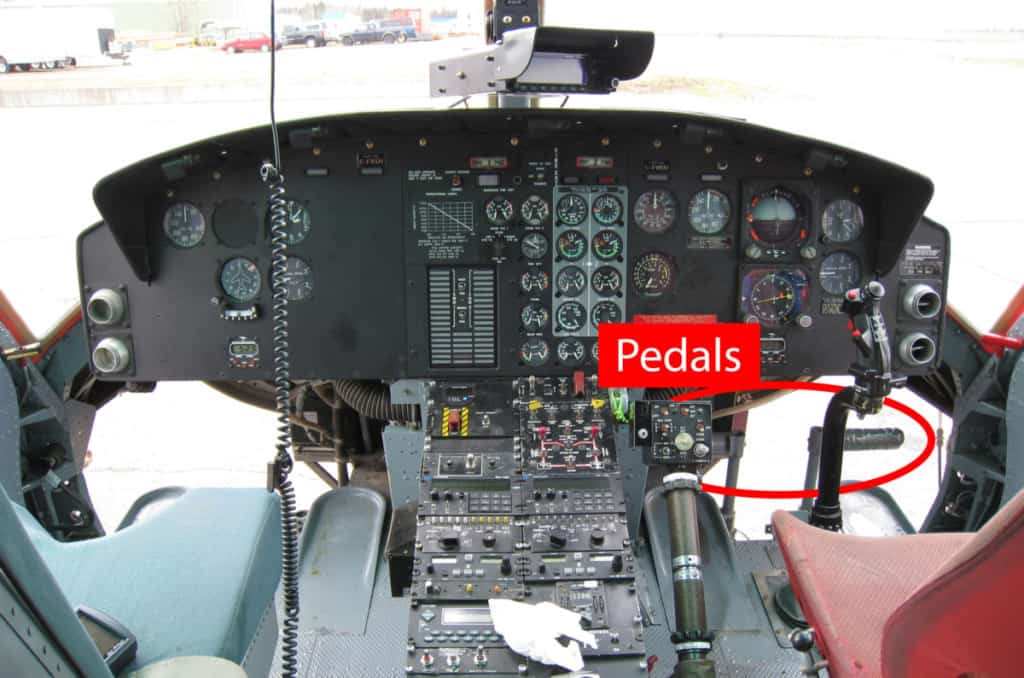
Each of the pilot’s feet rests against a pedal. As the pilot pushes on their right or left foot this causes a mechanical linkage to adjust the pitch angle of each tail rotor blade collectively. The pedals are joined so when you push on one, the other comes forward.
By adjusting how much thrust the tail rotor system creates it allows the pilot to rotate the nose of the helicopter to the left by pushing the left pedal, or right by pushing the right pedal.
When the pedals are centered or neutral the helicopter maintains its position pointing forward.
To master the hover each pilot must learn to move all of these controls in unison and by the correct amounts to one another.
To find out why it is hard to do this I highly recommend you read this article:

